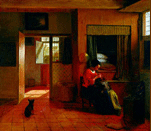










Adrian W. B. Randolph
Department of Art History
Dartmouth College
Cities are both physical and metaphysical. Inhabitants of and visitors to late medieval and Renaissance Italian cities could hardly have overlooked the impressive physical substance of these places: the sun-dried bricks, sandy mortar, and rough stone, as well as the hewn wood and waxy canvas windows. Often defended by soaring walls and governed from novel and impressive communal structures, these cities posited an enduring model of civic life. The lively economic exchanges and sociability of the street and piazza existed in other settings before, but their physical and metaphysical elaboration shaped urban experience in new ways.
Physically, streets became the focus of campaigns of straightening, cleaning, paving and naming, while Italy’s famed city-squares were defined through consciously-undertaken systematization. The history of the physical character of the late medieval and Renaissance city is well-known to historians of architecture and urbanism. The metaphysical recoding of the city and its spaces has also attracted som attention. But the gendering of these spaces has received scant notice. With this essay, I would like to contribute to discussions concerning the city as a symbolic, meaningful space by considering how it was represented, and how gender figures in its representation.
To some, the introduction of gender into the history of urbanism may seem to reflect narrow scholarly interests—the mapping out of disciplinary terrain. But, I would like to argue forcefully that the metaphysical elaboration of urban space in terms of gender lies at the very core of how the city was represented in early modern Europe, and therefore what the word “city” meant to early modern Europeans.
The paper offers an analysis of pictorial, and some textual, descriptions of urban space, understanding them not as passive reflections of an existing reality, but rather as models through which urban space was understood. The picturing of gendered spaces offered spectators a means of comprehending the social organizations within which they lived. Set into a dynamic relation with social historical information concerning city-live, these Renaissance Genderscapes help, therefore, to generate an understanding of the metaphysical elaboration of early modern urban life.
|
|
|
||||||
|
|
 |
 |
|
||||
 |
|
 |
|
||||
|
|
|
||||||
|
|
|
||||||
 |
|
||||||
|
|
|
||||||
| |
|
||||||
 |
|
||||||
 |
|
||||||
 |
|
||||||
 |
|
||||||
|
|
|
||||||
|
|
 |
|
|
||||
 |
|
||||||
|
|
|
|
|
|
|
|
|